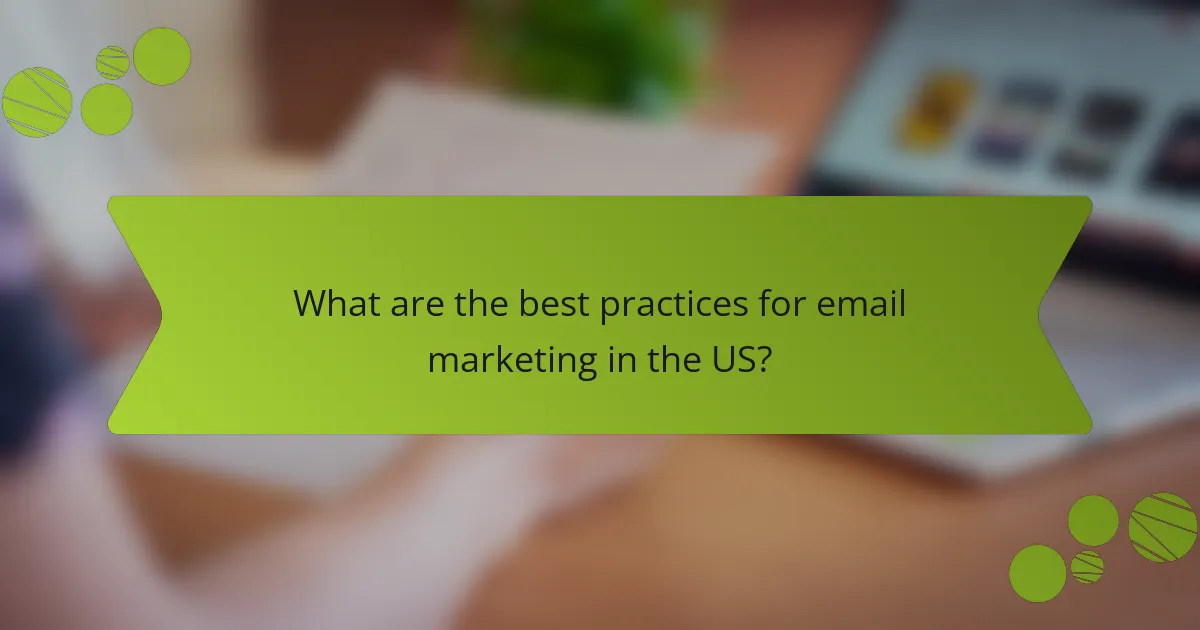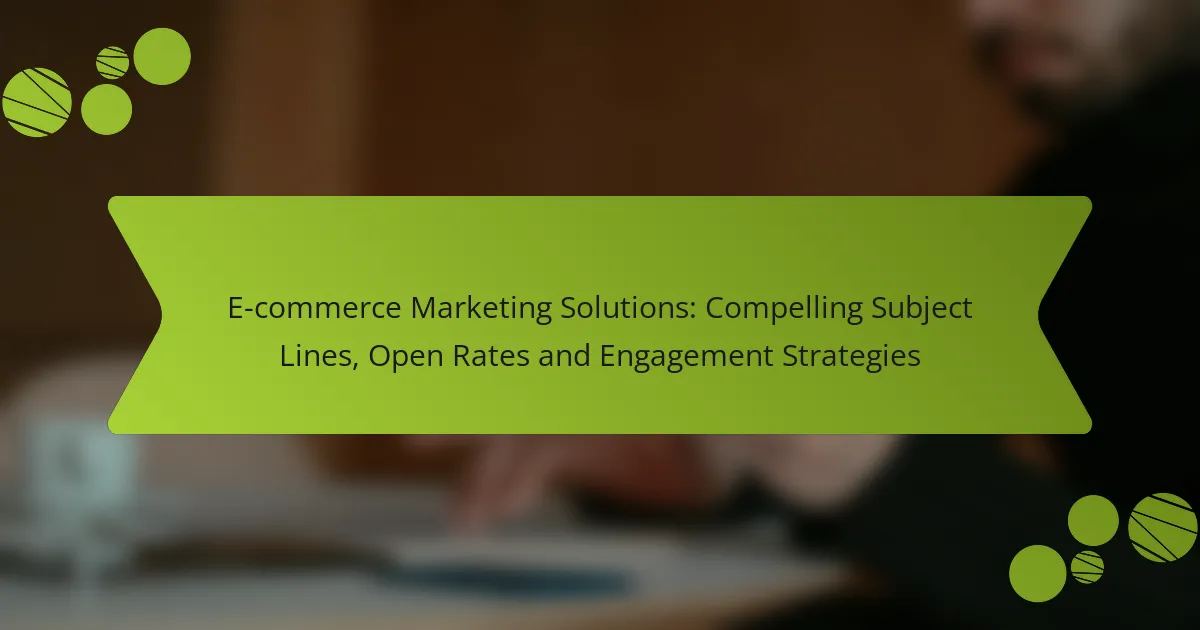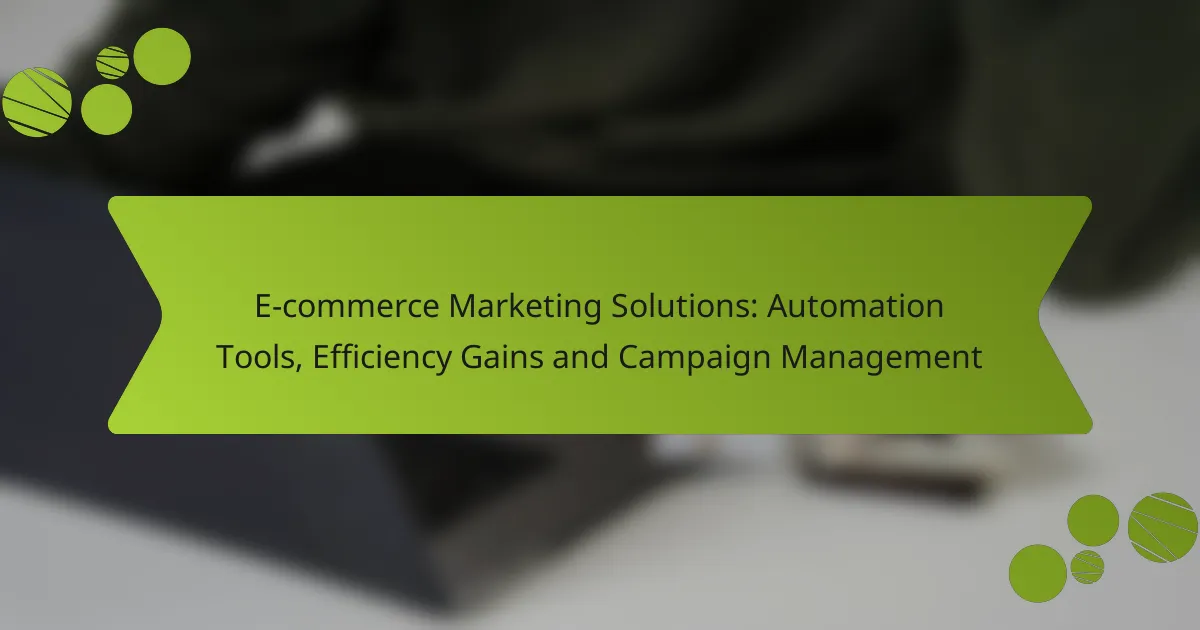In the competitive landscape of e-commerce, crafting compelling subject lines is essential for maximizing open rates and driving customer engagement. By employing strategies such as personalization, urgency, and continuous testing, businesses can create impactful communications that resonate with their audience. Focusing on clarity, relevance, and creativity in subject lines not only captures attention but also encourages recipients to take action.

What are effective e-commerce marketing solutions for subject lines?
Effective e-commerce marketing solutions for subject lines focus on capturing attention and encouraging opens. Strategies include personalization, urgency, and testing to optimize engagement rates.
Personalization techniques
Personalization techniques involve tailoring subject lines to individual recipients based on their preferences, behaviors, or demographics. This can significantly increase open rates, as emails that feel relevant to the recipient are more likely to be opened.
Examples of personalization include using the recipient’s name, referencing past purchases, or suggesting products based on browsing history. Aim for a balance between personalization and maintaining a natural tone to avoid sounding overly robotic.
Urgency and scarcity tactics
Urgency and scarcity tactics create a sense of immediate action by highlighting limited-time offers or low stock levels. Phrases like “Only a few left!” or “Sale ends tonight!” can prompt quicker responses from consumers.
However, it’s essential to use these tactics authentically. Misleading claims can damage trust and lead to higher unsubscribe rates. Always ensure that the urgency reflects actual availability or time constraints.
Use of emojis
The use of emojis in subject lines can enhance engagement by adding a visual element that stands out in crowded inboxes. Emojis can convey emotions or themes quickly, making the subject line more relatable and eye-catching.
When incorporating emojis, consider your target audience and brand voice. A playful emoji may resonate with younger consumers, while a more professional audience might prefer minimal or no emoji use. Test different approaches to see what resonates best.
Testing and optimization strategies
Testing and optimization strategies are crucial for refining subject lines to maximize open rates. A/B testing different subject lines allows marketers to compare performance and identify what works best for their audience.
Consider testing variables such as length, tone, and the inclusion of personalization or urgency. Regularly reviewing performance metrics will help you adapt your strategies and improve engagement over time.

How can subject lines improve open rates?
Subject lines play a crucial role in enhancing open rates by capturing the recipient’s attention and encouraging them to click. A well-crafted subject line can significantly increase engagement, making it essential to focus on clarity, relevance, and creativity.
Impact of A/B testing
A/B testing allows marketers to compare different subject lines to determine which one resonates better with their audience. By sending variations to a small segment of your email list, you can analyze open rates and engagement metrics to identify the most effective option. This iterative process helps refine your approach and can lead to substantial improvements in overall performance.
Consider testing elements such as tone, length, and urgency. For example, a subject line that includes a time-sensitive offer may perform better than a generic one. Regularly conducting A/B tests ensures your subject lines remain fresh and aligned with audience preferences.
Length and clarity considerations
The length of a subject line can significantly impact its effectiveness. Aim for concise subject lines, ideally between 40 to 60 characters, to ensure they display fully on most devices. Clear and straightforward language helps convey the message quickly, making it easier for recipients to understand the email’s purpose at a glance.
Using action-oriented words and avoiding jargon can enhance clarity. For instance, instead of saying “Exciting New Products Available Now,” a more direct approach like “Shop Our New Arrivals Today” may yield better results. Always prioritize clarity over cleverness to avoid confusion.
Relevance to audience
Relevance is key to crafting compelling subject lines that resonate with your audience. Tailoring your subject lines to reflect the interests and preferences of your target demographic can lead to higher open rates. Utilize segmentation to send personalized messages that address specific needs or behaviors.
Incorporating local context, such as referencing regional events or promotions, can further enhance relevance. For example, a subject line like “Exclusive Spring Sale for Our Boston Customers” speaks directly to a specific audience, increasing the likelihood of engagement. Always consider what matters most to your recipients when creating subject lines.

What engagement strategies boost customer interaction?
Engagement strategies that enhance customer interaction focus on personalizing communication, delivering relevant content, and optimizing timing. By implementing these strategies, businesses can significantly improve their open rates and overall customer engagement.
Segmentation and targeting
Segmentation involves dividing your email list into smaller groups based on specific criteria such as demographics, purchase history, or engagement levels. Targeting these segments with tailored messages increases the likelihood of interaction, as customers receive content that resonates with their interests.
For example, a clothing retailer might segment its audience by gender and send targeted promotions for men’s or women’s apparel. This approach can lead to higher open rates and conversions compared to generic emails sent to the entire list.
Content relevance and value
Content relevance is crucial for maintaining customer interest. Providing valuable information, such as exclusive offers, helpful tips, or personalized recommendations, encourages recipients to engage with your emails. When customers perceive the content as beneficial, they are more likely to open future communications.
Consider including user-generated content or testimonials to enhance credibility and relatability. For instance, a beauty brand could share customer reviews alongside product recommendations, making the email more engaging and trustworthy.
Timing and frequency of emails
Timing and frequency significantly impact customer engagement. Sending emails at optimal times, such as during lunch hours or early evenings, can increase open rates. Additionally, maintaining a consistent frequency—like weekly or bi-weekly—helps establish a routine without overwhelming subscribers.
Avoid sending too many emails in a short period, as this can lead to unsubscribes. A good practice is to test different sending times and frequencies to find what works best for your audience, ensuring you strike a balance between visibility and respect for their inboxes.

What metrics should be tracked for e-commerce marketing?
Tracking key metrics is essential for evaluating the effectiveness of e-commerce marketing strategies. Focus on metrics that reflect customer engagement, conversion success, and retention to optimize your marketing efforts.
Open rates and click-through rates
Open rates measure the percentage of recipients who open your emails, while click-through rates (CTR) indicate how many clicked on links within those emails. A good open rate typically ranges from 15% to 25%, whereas CTRs can vary widely but often fall between 2% and 5% for e-commerce campaigns.
To improve these metrics, craft compelling subject lines that resonate with your audience. A/B testing different subject lines can help identify what works best. Additionally, segmenting your email list based on customer behavior can lead to higher engagement rates.
Conversion rates
Conversion rates represent the percentage of visitors who complete a desired action, such as making a purchase. For e-commerce sites, a typical conversion rate might range from 1% to 3%, depending on the industry and traffic sources.
To enhance conversion rates, ensure your website is user-friendly and mobile-optimized. Clear calls-to-action and streamlined checkout processes can also significantly impact this metric. Regularly analyze customer feedback to identify and address potential barriers to conversion.
Customer retention metrics
Customer retention metrics track how well you keep customers coming back for repeat purchases. Key indicators include repeat purchase rate and customer lifetime value (CLV). A repeat purchase rate of 20% to 30% is often seen as a healthy benchmark for e-commerce businesses.
To boost retention, implement loyalty programs and personalized marketing strategies. Regularly engaging customers through email campaigns and offering exclusive discounts can foster loyalty. Monitoring these metrics will help you understand the effectiveness of your retention strategies and make necessary adjustments.

What are the best practices for email marketing in the US?
The best practices for email marketing in the US focus on compliance, engagement, and optimization. Marketers should prioritize building a targeted email list, crafting compelling subject lines, and ensuring mobile-friendly designs to maximize open rates and customer interaction.
Compliance with CAN-SPAM Act
Compliance with the CAN-SPAM Act is essential for email marketing in the US. This law mandates that marketers include a clear opt-out option in every email, honor unsubscribe requests promptly, and provide accurate sender information.
To ensure compliance, regularly review your email practices. Use a reliable email service provider that offers tools for managing subscriptions and tracking compliance. Failing to adhere to these regulations can lead to significant fines and damage to your brand’s reputation.
Mobile optimization techniques
Mobile optimization techniques are crucial as a significant portion of email opens occurs on mobile devices. Emails should be designed with responsive layouts that adapt to various screen sizes, ensuring readability and ease of interaction.
Consider using larger fonts, concise subject lines, and clear calls to action. Test your emails on multiple devices before sending to ensure a seamless experience. A well-optimized email can lead to higher engagement rates and improved conversion outcomes.

How can e-commerce brands leverage automation?
E-commerce brands can leverage automation to streamline marketing efforts, enhance customer engagement, and boost sales. By implementing automated systems, brands can deliver timely and relevant communications, ultimately improving customer experiences and increasing conversion rates.
Automated email campaigns
Automated email campaigns allow e-commerce brands to send targeted messages based on customer behavior and preferences. These campaigns can include welcome emails, abandoned cart reminders, and post-purchase follow-ups, ensuring that customers receive relevant content at the right time.
To set up automated email campaigns, brands should segment their audience based on factors like purchase history and browsing behavior. This segmentation helps tailor messages, increasing the likelihood of engagement. For example, a brand might send a discount offer to customers who haven’t made a purchase in a while.
Behavioral triggers
Behavioral triggers are specific actions taken by customers that prompt automated responses from e-commerce brands. Common triggers include signing up for a newsletter, viewing a product, or abandoning a shopping cart. These triggers enable brands to engage customers with personalized messages that encourage further action.
Implementing behavioral triggers requires tracking customer interactions through analytics tools. Brands should define key actions that indicate interest and set up corresponding automated responses. For instance, if a customer leaves items in their cart, an automated email could remind them of their abandoned items, potentially increasing conversion rates.








